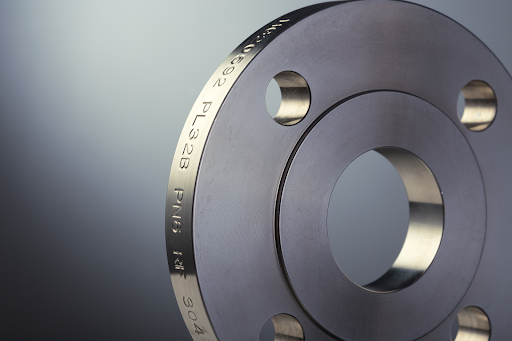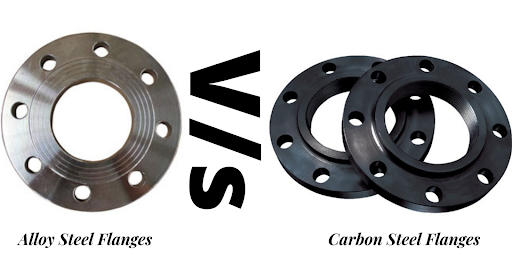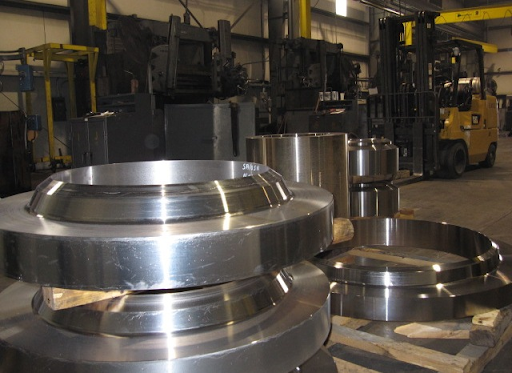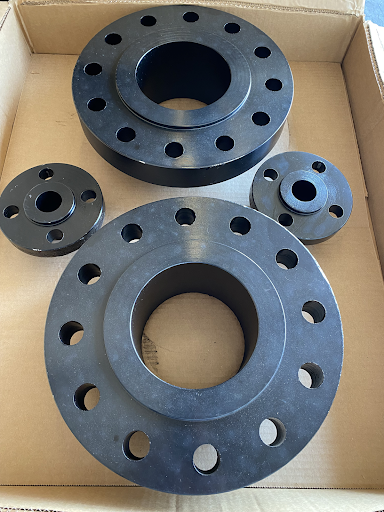Flanges steel serve as vital components in numerous industrial systems, connecting various parts efficiently. These steel rings, either forged or cast, are essential for joining pipes, valves, and pressure vessels. In this article, we explore flanges steel in detail, discussing their types, materials, applications, and more.
Image Source: Texas Flange
Understanding Flanges Steel
Flanges steel are designed to connect and support columns, beams, and pipes. Their primary roles include reinforcing and securing these structural elements. These steel rings can take on various shapes, including round, square, or rectangular forms, showcasing steel’s versatility in construction.
Types of Flange Faces
Flanges usually have different types of faces, each suited to specific purposes:
- Flat Face: Offers a smooth and flat sealing surface.
- Raised Face: Features a raised ring around the sealing surface.
- Ring Joint: Designed with a groove to accommodate a metal ring gasket.
- Tongue-and-Groove: Contains alternating raised and recessed surfaces for improved alignment and sealing.
Flanges in Structural Steel
Apart from connecting components, flanges steel also finds use in creating steel sections. Two common examples are:
- Parallel Flange Channels: U-shaped beams widely used in construction due to their strength and versatility in different sizes.
- Tapered Flange Beams: I-shaped sections, commonly seen in girder cross-sections.
Different Types of Standard Steel Flanges
Flanges steel come in various forms, catering to specific needs. The primary standard steel flanges include:
Weld-Neck Flange
This flange connects to fittings by welding the flange’s neck, making it suitable for high-pressure and extreme-temperature applications.
Slip-On Flange
Slip-on flanges slide over pipes or fittings and are ideal for low-pressure applications, making pipe cutting easier due to their forgiving nature.
Socket Weld Flange
Similar to slip-on flanges, socket weld flanges are used for smaller high-pressure applications. They attach via a fillet weld.
Lap Joint Flange
Lap joint flanges are practical for projects requiring disassembly for maintenance or inspections. They slide over pipes or fittings rather than being welded.
Threaded Flange
Threaded flanges eliminate the need for welding as they attach by threading the bore. These flanges are common in low-pressure applications and threaded fittings.
Blind Flange
Also known as blanking flanges, these lack a bore and are used for various purposes, such as sealing, isolating, or closing pipelines. They excel in high-pressure applications.
Materials for Flanges Steel
Image Source: Texas Flange
The choice of materials for flanges steel depends on specific applications and environmental conditions. Common materials for flanges steel include:
- Carbon Steel: Used in various forms, such as ASTM A105/A266 Gr.2 for high-temperature applications, ASTM A350 LF1 to LF3 for low-temperature applications, and ASTM A694 Gr. F42/F52/F56/F60/F65 for high-yield carbon steel flanges.
- Alloy Steel: Examples include Alloy 20, many other H grades for alloy steel flanges.
- Stainless/Duplex Steel: Stainless steel flanges like A-182 – F-304, Dual Grade 304/304L, Dual Grade 316/316L, 316, 304H, Dual Grade 304/304H, Dual Grade 316/316H, 316H, 309, 310, 317L, 321, 347, 347H, 904L, and F51/2205, F53/2507 are common choices.
- Titanium: Gr2, Gr12 is used for titanium flanges.
- Other Materials: Depending on specific applications, flanges steel can be made from materials like aluminium, copper, and polypropylene.
Measurement and Standards
Flanges steel adhere to various standards, including:
- DIN: Commonly used in the European Union for forged stainless or steel flanges.
- ASTM: ASTM specifications regulate approved raw materials and specifications for stainless flanges (ASTM A.182) and forged carbon steel flanges (ASTM A105).
- ANSI: ANSI standards govern dimensions and tolerances for steel pipe flanges and flanged fittings (ANSI B. 16.5), valves connected by flanges (ANSI B. 16.34), and more.
- ASME: ASME Code Section VIII provides procedures for calculating dimensions for pressurized vessel flanges, among others.
Manufacturing Methods
Flanges steel can be manufactured through two main methods: forging and casting. These methods have distinct characteristics and are chosen based on various factors.
Image Source: Texas Flange
Forging
- More expensive than casting.
- Results in a more precise shape.
- Provides higher tensile strength.
- Suitable for high-pressure applications.
- Resistant to rust due to lower carbon content.
Casting
- Used for non-pressure pipelines.
- Offers flexibility for complex profiles.
- May produce uneven grain structures.
- Utilizes centrifugal machines for high-precision cast iron flanges.
- Typically less expensive than forging.
Coating Types
To protect flanges steel from rusting or corrosion, various coating types can be applied:
- Anti-rust painting.
- Oil varnishing.
- Electric zinc coating (white or yellow zinc).
- Alloy material coating (lined or clad).
Common Types of Carbon Steel Flanges
Image Source: Texas Flange
- Weld Neck Flange
- Slip-On Flange
- Blind Flange
- Socket Weld Flange
- Threaded Flange
- Reducing Flanges
FAQs (Frequently Asked Questions)
- What are flanges steel, and what is their primary function?
Flanges steel are forged or cast ring-like devices made of steel. Their primary function is to connect different sections of pipes or join pipes to pressure vessels, pumps, valves, or other equipment, providing strength and support.
- What are the different types of flange faces and their applications?
Flange faces come in various types, including flat, raised, ring joint, and tongue-and-groove. Each type serves specific purposes, such as sealing, providing stability, or accommodating movement in different industrial applications.
- What materials are commonly used to manufacture flanges steel, and how do I choose the right one for my application?
Flanges steel can be made from materials like carbon steel, alloy steel, stainless steel, nickel alloys, and more. The choice depends on factors such as temperature, pressure, and compatibility with the substances being transported in your system.
- How are flanges steel measured, and what standards should I be aware of when selecting them?
Flanges steel are measured by their size, outside diameter, pitch circle diameter, and flange thickness. You should be aware of standards like ANSI B16.5, B16.34, B16.47, SP44, and API 605 to ensure you choose the right flanges for your needs.
- What are the main differences between forging and casting when it comes to manufacturing flanges steel?
Forging involves shaping the flange under pressure, resulting in better mechanical properties. Casting, on the other hand, melts the material and pours it into a mold, which may be more cost-effective but can lead to variations in quality.
- Can you explain the coating options available to protect carbon steel flanges from rust and corrosion?
Carbon steel flanges can be coated with options like anti-rust painting, oil varnishing, electric zinc coating, or alloy material coatings. These coatings provide protection against rust and corrosion in various environmental conditions.
- How can I ensure the proper installation of flanges steel in my industrial system? – Proper installation involves ensuring correct alignment, torque, and gasket selection. Following industry best practices and manufacturer guidelines is essential for a reliable installation.
- What industries commonly use flanges steel, and why are they essential in these sectors? –
Industries such as oil and gas, petrochemicals, construction, and manufacturing commonly use flanges steel because they play a crucial role in connecting and sealing pipelines and equipment, ensuring safe and efficient operations.
- Are there any eco-friendly practices related to the use and disposal of flanges steel?
Reusing or recycling steel flanges when possible can reduce environmental impact. Proper disposal methods should be followed to minimize environmental harm.
- How do I prevent common issues like leaks or corrosion in flanges steel over time?
Regular maintenance, proper material selection, and choosing the right gaskets and coatings can help prevent common issues like leaks and corrosion in flanges steel.
Conclusion
Flanges steel are essential components in various industrial applications, providing strength and reliability in connecting different parts of pipelines and systems. Whether it’s a high-pressure pipeline or a structural steel beam, flanges steel play a crucial role in ensuring seamless operations and structural integrity. Understanding the different types, materials, and standards associated with flanges steel is essential for selecting the right components for specific needs.For more info Visit: https://en.wikipedia.org/wiki/Flange
For all your flange steel requirements, consult with reputable manufacturers and suppliers like Texas Flange who can provide the right flange solutions tailored to your application’s demands.



